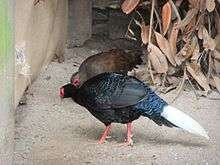Vietnamese pheasant
| Vietnamese pheasant | |
|---|---|
 | |
| A pair at Camperdown Wildlife Centre, Dundee, Angus, Scotland | |
| Scientific classification | |
| Kingdom: | Animalia |
| Phylum: | Chordata |
| Class: | Aves |
| Order: | Galliformes |
| Family: | Phasianidae |
| Subfamily: | Phasianinae |
| Genus: | Lophura |
| Species: | L. edwardsi var. |
| Binomial name | |
| Lophura edwardsi var. | |
The Vietnamese pheasant, or Vietnam fireback, was formerly considered a species of gallopheasant, Lophura hatinhensis, but is now considered a variant of Edward's pheasant. Discovered in 1964, it is endemic to central Vietnam. Its range concentrates around Kẻ Gỗ Nature Reserve in Hà Tĩnh Province.[1]
This pheasant has a very small and severely fragmented range and population, which are continuing to decline owing to destruction of its specialised lowland forest habitat and high levels of hunting. These factors currently combine to qualify it as Endangered. As of 2012, continued habitat loss and hunting could require uplisting to Critically Endangered in the very near future.[2]
Habitat
The fireback inhabits primary and secondary (including logged) evergreen forest in lowlands and hills from sea-level (at least historically) to c.300 m. It may tolerate habitat degradation, but is apparently far more common in closed-canopy forest, and has been trapped in dense streamside vegetation.
References
- ↑ BirdLife Species Factsheet
- ↑ BirdLife International 2012. Lophura hatinhensis. In: IUCN 2012. IUCN Red List of Threatened Species. Version 2012.2. http://www.iucnredlist.org. Downloaded on 16 December 2012.
- Hennache, A., S.P. Mahood, J.C. Eames, and E. Randi. 2012. Lophura hatinhensis is an invalid taxon. Forktail number 28: 129-135.
